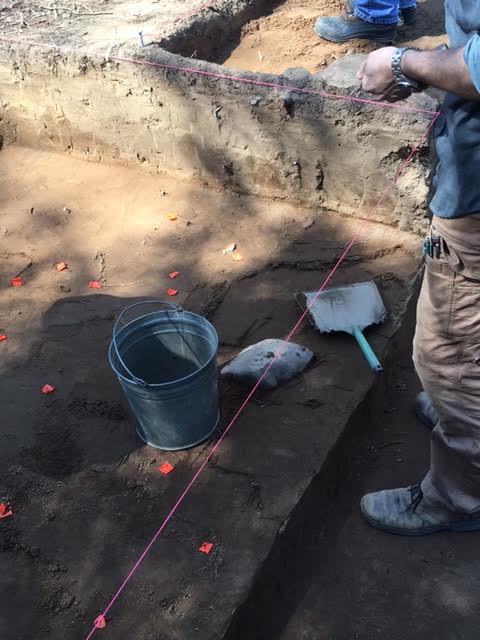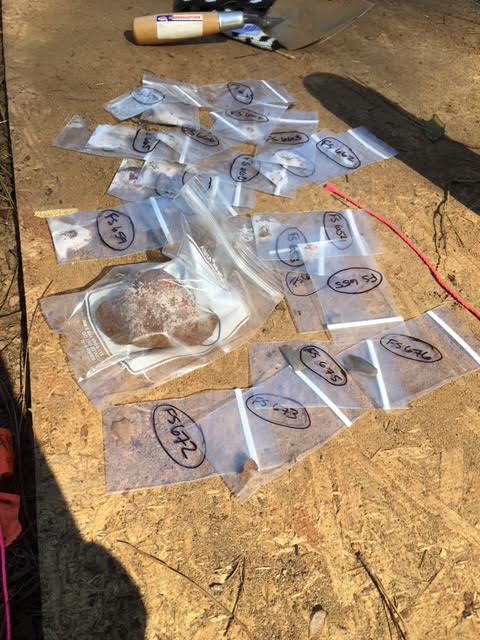|
Today our goal was to reach finish Level 7 at a depth of 90 cmbd (cm below datum). We arrived at the excavation site at 9:00 a.m. Last week the charcoal feature inside of our unit, Unit 6, was taken out for closer examination and to be processed as a float sample.
Our starting depths were between 75.5 cm and 78 cm, so we would have to work slowly and cautiously as we continued to dig deeper down towards 90 cmbd. Dr. White believes that we are entering an intact prehistoric layer because as we are digging, artifacts are popping up everywhere. Objects such as ceramics, lithic flakes, and fire crack rock are cautiously piece plotted so my group can map out where each and every artifact is found. One of our coolest finds today was a bifacial stone point which was cream-colored and appeared to have had percussion flaking along the edges. Every time that we prepare the unit for a photo, we have to start from one edge of our 2 x 2 and carefully scrape towards the opposite side. This allows for a cleaner and better view for how the unit floor looks within the photo. I always feel nervous about scraping for photos because I do not want to accidentally scrape away too much soil from the floor, or have to start over from not moving slow enough. That is one thing that I have learned from archaeology, that it takes a lot of patience and an individual must work meticulously. Since everything that we do in the field school, is effectively destroying the original context of what's there, we have to record, map, and take photos of everything so that when a future archaeologist is pondering over data within the lab, they will be able to visualize and understand how everything was excavated. Keeping bad records will result in lost data and a lack of understanding when reviewing over site record. This is one of the reasons why methodology is key when participating within excavation and artifact data collection. Until the next time!
0 Comments
Day 8 was sunny, but a little chilly. It has been a mild South Carolina winter, and the arrival of the pollen tells me that is over. There was only a small amount of water in the units, and so removal this time was quick. I was assigned to Unit 5 again, and have been working in that unit since it was started. Professor White instructed us where to end the level and only to piece-plot larger artifacts. We had uncovered a large rock in Unit 5 on day 7, and it only continued to grow as we exposed it further. There are plow scars on the top of this rock, and we are unsure what it was for. We are carefully excavating around it, in case there are any artifacts near it. The tarp follows the lines of the units to allow any rain water to settle naturally at the lowest point. The buckets prevent the tarps from moving while we are not at the site. DuVal shows us how to work around the large rock while Elena removes loose soil. Once we got to the floor of level 5, we started the next level. We were instructed to piece-plot everything, and continue slow excavation around the large rock. Professor White also noticed what could be a feature in the northern edge and wall, so we attempted to leave that undisturbed. If it turns out to be a feature, we will excavate it a different way than what we have been practicing. Piece-plotting with the goal of marking everything requires careful shovel work. After removing just a couple centimeters of soil, we had 39 artifacts flagged. These included the usual pottery fragments, rocks and flakes, but we also began to see burned clay. A clean floor, but not for long. The light stripes are dry patches of soil. The orange flags mark artifacts. Notice the increased size of the large rock. The same rock from the other side of the unit. It is still firmly in the ground. There were several items that we flagged that later turned out to be no bigger than a few millimeters. Only two of us were assigned to unit 5, and so the process of plotting was slow. One of us measured the northing, easting and elevation, while the second person recorded these measurements, placed artifacts in bags, and mapped the points on a grid. To map the large rock, we measured the corners of it, plotted those corners, and drew in the curves. Once an artifact's provenience has been recorded, it is placed in a bag with the assigned number. Elena measures artifacts for piece plotting. Professor White examines unit 5 for signs of a feature. Unit 3 had been left undisturbed until day 8. Our units are getting deep, and so Unit 3 is being cut to act as a stair for safer access. This unit also had a large stump that housed an anthill, and a couple of dung beetle larvae. I do not envy my classmates who are working on this unit, but I found the beetles to be an exciting addition to the fauna that are present at the site. I enjoy learning more about archaeology every week, but I also enjoy spending the day in nature and learning more about that as well. End of day 8. Notice the different levels of the units, and the stair in unit 3. The beautiful Broad River, a great place to spend the lunch break.
|
Student Blog (2017)Blog posts written by the students of the 2017 Broad River Archaeological Field School Archives
April 2017
Categories
All
|











 RSS Feed
RSS Feed
